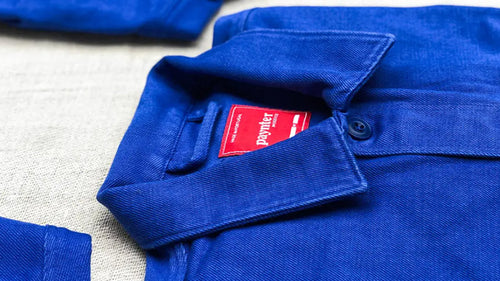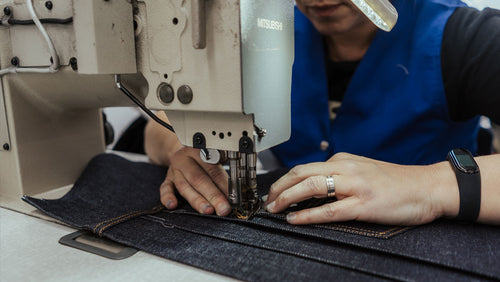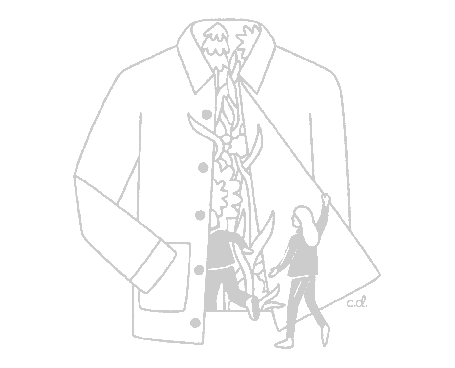
Before we started this whole thing, we knew it had to be called Paynter.
We’re lucky in that respect, there was no back and forth trying to figure out a ‘good’ name. We often get asked why we’re called Paynter. People tend to jump to the conclusion that it’s a play on the word Painter, the nickname of chore jackets worn by, well, painters.
But no, the reason is quite simple and this man is entirely responsible: Our namesake, Andrew Paynter.
In July 2018, we both met Oakland California based photographer, Andrew Paynter at The Do Lectures. He was there to speak about his observational style of work, a 10 year project shooting the artist Geoff McFetridge, and his work for Hiut Denim’s annual yearbooks documenting the ideas company that sells jeans.
Andrew is as calm and considered as his photographs would have you imagine. Talking over a coffee, the topic of conversation quickly turned to clothing. He shared stories about his love for certain pieces, like his RRL Officer Chinos, and a few vintage military jackets he’d collected over the years.
He even told us about his quest to have particular vintage jackets re-made to suit his lifestyle as a photographer; tweaking pockets to perfectly fit new film and another for exposed film. No detail was overlooked.
We never forgot those stories, and feel so lucky to count Andrew as a friend. So when it came to naming our jacket making side-project back in August 2018, the name Paynter felt just right. And thankfully, we had his permission.
...
...
Could you set the scene? Where are you?
AP: I live in Oakland California and grew up in North Carolina, on the East coast of the US in a city that once prided itself on tobacco. I have fond memories of that sweet smell of tobacco being cooked at the factories downtown when I was younger.
Let’s start with photography. How do you prefer to work? Documentary? Studio set up?
AP: I like both for very different reasons. In the field, it’s exciting because you have no control. The light does what the light wants to do, the energy and people move about how they want to. The challenge is catching those moments whilst having an understanding of the composition and when to shoot vs when not to.
In the studio, it’s all about control and time, which feels expansive. I feel like there’s time to experiment and play around a little. There’s also nothing but a backdrop (I really never use props or build sets), so the subject is isolated and it’s 100% about the subject and your relationship with them. It’s also very collaborative, which I love since photography can be so solitary.

What got you into photography in the first place, and how did you develop your style?
AP: I would say I have no real formal training, albeit I took a class in art school, where I was studying painting. I primarily learned through my grandfather Bertram Couch Payne, as well as books, trial and error in the darkroom (many long long nights) and over time by people in the field generous enough to teach me, like Danny Clinch and Cheryl Dunn, two New York City based photographers.
I feel like it took years to really hone in on what it is I wanted to do with my pictures. I always had the same idea and target, it just took me a long time to get there.
Do you have any particular influences?
AP: There are tons.
Photographers: Irving Penn, Richard Avedon, Bresson, Koto Bolofo, Danny Clinch, David Duncan Douglas among others.
Directors: Hitchcock for his sense of colour and dreamy landscapes. Wong Kar Wai for his sense of depth and textures and colour in his films. Michelangelo Antonioni for his wild and vivid landscapes and colour palette. Jacques Tati for his sense of graphic, colour and stylisation in his films.
Painting is also very much an influence. I grew up admiring 19th century landscape paintings of the hills, mountains and the sea.
When you were starting out, did you work as an apprentice for anyone?
AP: Not technically, but Danny Clinch really let me in and taught me a lot and was very supportive of my early work and encouraged me to keep shooting. I’ve always admired Danny and his creativity. He’s a remarkable person and very accomplished.
Tell us about the type of project that gives you energy.
AP: I suppose the projects that give me energy are the ones where I really feel like I’m having an impact on the matter and that my presence is not only welcomed, but needed. There’s a variety of projects I’ve done or continue to do that makes me feel this very sensation, which is nice and rewarding. It also helps influence longer term projects.

Talking of long term projects, you've collaborated with Geoff McFetridge for 10 years now.
AP: Yes, 10 years is nuts in this time and age. I met Geoff while living in Los Angeles. I photographed him for an Australian fashion magazine. After the shoot, Geoff mentioned he was going to Holland for a month to do a solo show at the Mu in Eindhoven. He asked if I would join him and document the process, install etc. I said yes and at the end of it, after reviewing all the contact sheets, I said to Geoff, had he ever seen this book by David Duncan Douglas about Picasso. Of course not only had he heard of it, but he also owned the book, as did I.
I wanted to do something similar, documenting him over the course of 10 years. I asked Geoff and he agreed. I think having seen all the work I did in Holland helped make that happen, as some nice moments came from that trip. There are so many people doing projects documenting people, their work, studios etc, over the course of a day or two. I wanted to do something that was far more of a commitment to seeing growth over time. I do see it continuing in some way. We are actually at year 12 now. I was just in France with him by the Sea in the Southwest of Basque country. We’ll see how long it goes before the first book (if there are others) will be produced and published.

Do you have time for any personal projects?
AP: Well, the Geoff book is certainly one. I’ve also been photographing several other artists for years, one of which is Evan Hecox. I want to also do a book of polaroids of him. I have over 120 unique polaroids of Evan working in his studio, at home etc. It could be nice to do a book from a bygone era film.
I’m working on another book, also on polaroid of compositions I would see on morning walks over the course of a Summer last year. The compositions, to me are like music and the nature of their complexities evoke something sonic and meditative, to me. The film produces a positive (print) and negative (film), which is unique. I'm not sure which of the two I would reproduce.
Lastly, I’m starting a project photographing various people from various demographics reading. Reading is something I love to see in the public, and just don’t see as much as we used to (and I mean reading books).
You’re a very well dressed man, and very particular about your clothing. How did you get into clothing?
AP: Thank you. I certainly would not consider myself a ‘fashion’ person, but I am very particular about the way I dress. So much of the way I dress is / was informed by my childhood and how both my father and grandfather dressed. They were / are both very stylish men.
As a Southerner, there’s a bit of a ‘uniform’ that was just how we dressed as young people growing up. I never strayed too far out of that zone. I guess I got interested in clothing when I started to shoot for brands that made shoes and clothes. I also dated a fashion designer when I was much younger, and she kind of taught me a lot about clothing.
You skate too. Has the culture has influenced your style?
AP: Yes, I’ve been skateboarding since I was in grade school. Skate culture then was very very different from what it is now. Information was not as accessible, particularly due to geography and lack of distribution.
You really had to work hard to see what was happening on the West coast. Skateboarding definitely influenced the way I dress, although I never really succumbed to the whole 90’s big clothing thing. But what was fascinating about skateboarding were all the vehicles that were created to promote it, like film making, photography, graphic design etc. Those were the things that were exciting to me. The colour ways of boards, wheels and all the graphics.
As young people, we all have such a heightened sense of thinking and fantasy. It all really was an exciting time, albeit it was certainly not ‘en vogue’ where I grew up. We were all considered ‘outsiders.’
We've heard a lot about the vintage pieces you've had tailored. Could you tell us how it began?
AP: Sure. I have always loved vintage military clothing, for the reason of two things: they are utilitarian and I’ve always loved the colour palette.
There’s a herringbone war shirt with oversized pockets that I’ve always loved. The left pocket was for unexposed film and the right pocket was for exposed film.
You could probably put at least 20 rolls of film in each pocket. In San Francisco I met a woman named Ji Sun who at the time was making patterns and sewing finished pieces for a few of my friends in fashion. Eventually Ji Sun wanted to do her own thing and asked if I would shoot it. We did a skill swap deal and she made me some incredible pieces, one of which is a remake of that oversized shirt with the large pockets.
Ok, so what would be your ideal jacket? And why?
AP: I’ve always LOVED anorak pullover jackets.
Ever since I was a Boy Scout, I’ve had a love for those jackets. I don’t know why, but I love them. They're light weight layers and honestly perfect for the San Francisco climate. You can wear them year around.

Us: Right then. We’ll have to get working on an anorak pullover for AP himself.
...
A big thank you to Andrew for taking the time out to for this interview, and to take the photos of his wardrobe. Every photo used in this piece are his own, and most can be found on his website andrewpaynter.com.
If you'd like to see more, we'd recommend watching his talk at The Do Lectures, from the weekend in 2018 when we first met, or if you’d like to learn more about Andrew and his photography process, he has a book all about it which you can check out here. Enjoy!


















